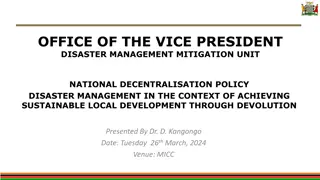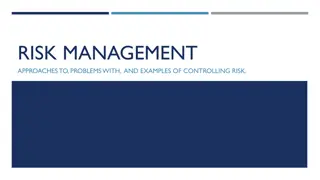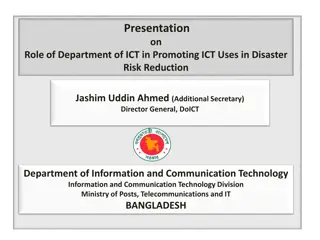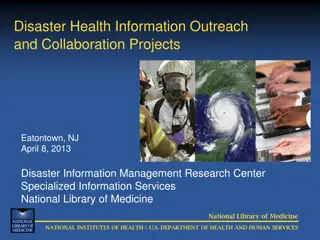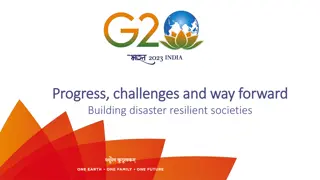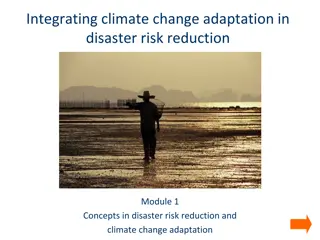Disaster Risk Management Training Programme Overview
This presentation provides an overview of a Disaster Risk Management (DRM) Training Programme, aiming to raise awareness about different types of disasters, their impacts, and the importance of having a DRM plan. It includes modules covering topics such as DRM framework, risk assessment, post-disaster assessment, and more. Participants will learn about natural and man-made disasters, their characteristics, and how to develop country-specific DRM plans.
Uploaded on Sep 15, 2024 | 0 Views
Download Presentation

Please find below an Image/Link to download the presentation.
The content on the website is provided AS IS for your information and personal use only. It may not be sold, licensed, or shared on other websites without obtaining consent from the author. Download presentation by click this link. If you encounter any issues during the download, it is possible that the publisher has removed the file from their server.
E N D
Presentation Transcript
WELCOME TO DISASTER RISK MANAGEMENT TRAINING PROGRAMME PPT 1.1
General Aims To raise awareness amongst the trainees about various types of disasters, their adverse impacts and the need to have a sound DRM Plan in each postal administration To impart necessary knowledge and skills about industry best practices procedures (i.e. DRM tools and products) to deal with disasters To enable the trainees to develop their respective country-specific and hazard-specific DRM Plan and standardised PPT 1.2
7 Modules in DRM Programme The seven modules in this programme are: 1. Purpose and International DRM Framework 2. Basic Principles of DRM 3. Understanding Risks Vulnerability and Risk Assessment 4. The Five Phases of DRM 5. Post-Disaster Damage and Needs Assessment 6. Partners and Resources for DRM 7. Characters of major natural disasters and Checklists for each disaster PPT 1.3
MODULE 1 Purpose and International DRM Framework PPT 1.4
Module 1: Performance Objectives At the end of this Module, the trainees will be able to explain: what is a disaster and the various concepts and terminologies used in a DRM Plan the purpose of having a DRM Plan in each postal administration PPT 1.5
Activities in this Module 1. Go through the presentations 2. Go through Appendix A of UPU Guide to know about various types of natural disasters, their causes 3. List the disaster(s) commonly faced in your country 4. Complete the Progress Test Q 1.1 at the end of the module PPT 1.6
What is a Disaster? A disaster can be defined as any occurrence, either natural or man-made: - That damages assets and infrastructure, causes loss of lives & ecological disruptions and deterioration of health and health services; - Creates human needs that the victims can not alleviate themselves; and - Warrants an extraordinary response from outside the affected community or area. PPT 1.7
Natural and Man-made Disasters NATURAL MAN-MADE OR TECHNOLOGICAL 1. Biological (Disease Epidemics, Insect/Animal Plagues or Infestations) 1. Industrial Accidents (Chemical Spills, Radio-active Spills) 2. Geophysical (Earthquakes, Tsunamis, Landslides, Volcanic Eruptions) 2. Transport Accidents/ Failures 3. Climatological (Drought, Wildfires) 3. Complex Emergencies/ Conflicts, Warlike Encounters, Famine 4. Hydrological (Floods) 5. Meteorological (Storms, Cyclones/ Hurricanes/ Typhoons, Tornadoes, Snow Storms) For more details, refer to Appendix A of UPU DRM Guide. PPT 1.8
Disasters in recent years In recent years, a number of countries and their postal administrations have been affected by various natural disasters. For example: Earthquakes in Chile (2010) and Japan (2011) Super-storm Sandy in USA (2012) Typhoon Haiyan in Philippines (2013) Earthquake in Nepal (2015) PPT 1.9
Disasters in recent years (contd.) During October 2013 to December 2015, UPU recorded a total of 45 disruptions to international mail service in different regions due to 19 Floods 13 Winter-storms 5 Hurricanes/ Cyclones/ Typhoons 3 Volcanic Eruptions 2 Earthquakes 1 Landslide, 1 Thunderstorm & 1 Wildfire PPT 1.10
Impacts of the Disasters These disasters resulted in Huge economic losses for the postal administrations; Damage to postal assets and infrastructure; Disruptions in mail services in the affected countries ; and Damage & loss of postal items and delays in worldwide mail processing. In general, impact on low-income countries is found to be more than impact in high income countries PPT 1.11
Why a Disaster Management Plan for the Post? Postal services are vital to a nation for communications, money transfers (e.g. Money Orders), distribution of money to the poor under various social benefit schemes etc. Its assets and infrastructure are part of national infrastructure which need protection from disasters Postal services have strong logistics and distribution infrastructure and therefore, can be a key player in national disaster responses, serving as a distribution point for emergency supplies, coordinating emergency aid operations, facilitating money transfers to affected areas etc. Generally, one of the first government services which starts functioning & gives indication of community s return to normalcy. PPT 1.12
UPU DRM Guide The UPU DRM Guide Building Resilience A Guide to Disaster Risk Management , brought out in 2016, outlines standardised procedures for responding quickly to disasters and recovering expeditiously from disruptions and emergencies to mail infrastructure Focuses both on pre-disaster Disaster Risk Reduction (DRR) measures like risk prevention, mitigation and preparedness and post-disaster response and recovery activities PPT 1.13
UPU DRM Guide (contd.) Incorporates industry best practices such as those identified in UN Plan of Action on DRR (2013) and Sendai Framework for DRR (2015) Inputs in this training programme have been drawn mainly from the UPU DRM Guide PPT 1.14
Concepts and Terminologies used in DRM PPT 1.15
1. Threats and Exposure to Threats A threat is a potentially damaging event, phenomenon or activity that can occur and has a detrimental effect on human lives, properties, etc. (e.g. damaging effects on postal facility and its operations) Exposure to threats: People, property, systems or other elements present in hazard zones that are thereby subject to potential losses PPT 1.16
2. Hazard and Disaster Hazard Natural phenomenon that can potentially trigger a disaster Example: Earthquake, Floods, Tsunami These events need not necessarily result in a disaster Disaster Serious disruption involving widespread human, material, economic or environmental losses and impact Hazards may be inevitable, but disasters can be prevented PPT 1.17
3. Disaster Risk Reduction (DRR) Actions that are taken in the pre-disaster phase to reduce the risk of disasters and their adverse impacts through systematic efforts Consists of: Risk Prevention Mitigation and Preparedness PPT 1.18
4. Disaster Risk Management (DRM) It is DRR, augmented by Response and Recovery activities in the post-disaster phase. Thus, DRM takes a holistic approach and consists of Risk Prevention Mitigation Preparedness Response and Recovery PPT 1.19
5.1. DRM Life Cycle PREPAREDNESS MITIGATION DISASTER RISK PREVENTION RESPONSE RECOVERY PPT 1.20
5.2. Disaster Management Strategies in 3 Phases of Disaster Post-disaster phase immediately after the disaster (0-48 hours) Post-disaster phase (48+ hours) Pre-disaster Phase [or pre-impact phase] [or Post Impact phase] [also called the impact phase] Risk prevention Mitigation Response Recovery Preparedness PPT 1.21
6. DRM Tools and Products These are standardised emergency procedures or response actions which are followed during the pre-disaster and post-disaster phases to face disasters effectively and to build resilience Also known as Emergency Procedures Checklists (Covered in detail in Module 7. Refer to Appendix B of UPU Guide) Postal administrations are encouraged to adapt and incorporate these tools in their DRM Plan PPT 1.22
7. Business Continuity Plan (BCP) A Plan to ensure that postal operators can start the most essential functions and customer service as soon as possible after the disaster, preferably immediately after the impact period At the same time, aims to mitigate the strategic, stakeholder and financial impact of a disruption. PPT 1.23
Key Components of a BCP Defining the business impacts, risks or vulnerabilities that could significantly affect postal operations Identifying the critical activities to be maintained after a disaster Providing for the continuation and effective performance of critical activities through several contingency scenarios PPT 1.24
Key Components of a BCP (contd.) Protecting equipment, records, etc.) and personnel required for performance of critical activities Reducing or mitigating the impacts of disruptions to operations critical resources (facilities, Additional BCP references are provided in Appendix E of the UPU Guide. PPT 1.25
8. Resilience The ability of a system, community or society exposed to hazards to resist, absorb, accommodate, adapt to, transform and recover from the effects of a hazard in a timely and efficient manner, including through the preservation and restoration of its essential basic structures and functions through risk management. (UNISDR, February 2017) PPT 1.26
9. DRM Framework Legal, institutional & policy frameworks and administrative mechanisms & procedures related to management of risks and disasters, including the emergency management elements DRM framework considers DRM as a continuum and thus as an ongoing process of inter-related actions which are initiated before, during and after disaster situations PPT 1.27
Progress Test Q. 1.1 PPT 1.28







